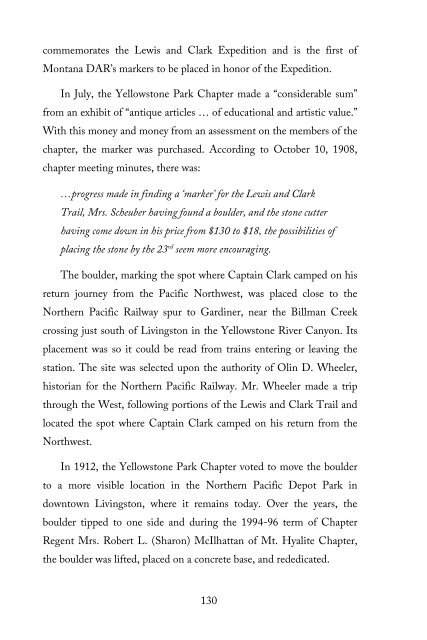Montana's DAR Markers . . . Honoring Where History Was Made
This book is a 200-page thank you to the women of Montana State Society Daughters of the American Revolution for their work in placing historical markers across the state of Montana. Starting in 1908, Montana DAR has installed 70 historical markers across the state. Of those, 33 remain. This book records why the markers’ sites were selected, their history, and the backstory of each.
This book is a 200-page thank you to the women of Montana State Society Daughters of the American Revolution for their work in placing historical markers across the state of Montana. Starting in 1908, Montana DAR has installed 70 historical markers across the state. Of those, 33 remain. This book records why the markers’ sites were selected, their history, and the backstory of each.
Create successful ePaper yourself
Turn your PDF publications into a flip-book with our unique Google optimized e-Paper software.
commemorates the Lewis and Clark Expedition and is the first of<br />
Montana <strong>DAR</strong>’s markers to be placed in honor of the Expedition.<br />
In July, the Yellowstone Park Chapter made a “considerable sum”<br />
from an exhibit of “antique articles … of educational and artistic value.”<br />
With this money and money from an assessment on the members of the<br />
chapter, the marker was purchased. According to October 10, 1908,<br />
chapter meeting minutes, there was:<br />
…progress made in finding a ‘marker’ for the Lewis and Clark<br />
Trail, Mrs. Scheuber having found a boulder, and the stone cutter<br />
having come down in his price from $130 to $18, the possibilities of<br />
placing the stone by the 23 rd seem more encouraging.<br />
The boulder, marking the spot where Captain Clark camped on his<br />
return journey from the Pacific Northwest, was placed close to the<br />
Northern Pacific Railway spur to Gardiner, near the Billman Creek<br />
crossing just south of Livingston in the Yellowstone River Canyon. Its<br />
placement was so it could be read from trains entering or leaving the<br />
station. The site was selected upon the authority of Olin D. Wheeler,<br />
historian for the Northern Pacific Railway. Mr. Wheeler made a trip<br />
through the West, following portions of the Lewis and Clark Trail and<br />
located the spot where Captain Clark camped on his return from the<br />
Northwest.<br />
In 1912, the Yellowstone Park Chapter voted to move the boulder<br />
to a more visible location in the Northern Pacific Depot Park in<br />
downtown Livingston, where it remains today. Over the years, the<br />
boulder tipped to one side and during the 1994-96 term of Chapter<br />
Regent Mrs. Robert L. (Sharon) McIlhattan of Mt. Hyalite Chapter,<br />
the boulder was lifted, placed on a concrete base, and rededicated.<br />
130





